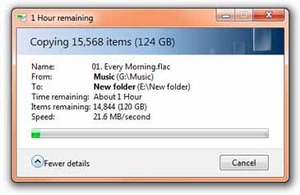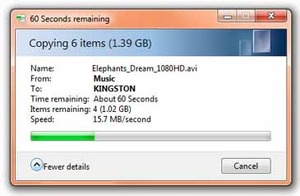Testing
The key question for any high capacity USB drive is practicality. Do I have to wait forever for my files? Unfortunately, the answer for the DataTraveler 300 is yes. The 20MB/s read speed isn't too bad - USB only has a maximum of 30-35MB/s depending on the chipset but the 10MB/s write speed is cripplingly slow.To put it in perspective, to fill the whole drive will take you seven hours. The sliver of hope is that it'll keep this speed consistently: between 9.7-10.7MB/sec according to Windows 7 RC1 x64 with an Intel ICH10R Southbridge.

It comes pre-formatted using exFAT, which Kingston claims performs better - up to 25MB/sec, however we never saw above 17MB/sec on our test PC with copying with both large (video) and small files (MP3 and FLAC audio).


Copying small files to the drive took about 7 hours and was a consistent 9.7-10.7 MB/sec


Reading from the drive performed at its rated speed of around 21-22MB/sec for the same small files, and copying large files like shown here is only marginally faster at 15-16MB/sec
Kingston PR claimed to us that no one will want to fill the drive in one go, but even using half of it will take three and a half hours - and why would you spend in excess of five hundred pounds sterling if you didn't absolutely need the super sized capacity with a minimal physical space requirement? I suppose, if you never wanted to delete a thing and constantly need to fill a single drive, day after day, it does offer this advantage, however you'll still be trusting all that data to a single place of non-fault tolerant storage, and if only progressive use of smaller files are stored, what about buying FTP space?
Value and Alternatives
Alternatives include a plain 2.5in drive and enclosure - over USB 2.0 the drive speed will be in excess of USB bandwidth so will always fill the 30MB/s. It's not so large, but a 2.5in drive isn't exactly pocket sized, although for £565 you could buy several 250-320GB 2.5in drives and new tailored trousers with larger pockets!Comparatively, a flash drive is very low power, but then again, if copying the data takes 3x less time it has to be at least 3x less power to warrant better efficiency. However, replace the hard drive with a 256GB SSD even for lower power use, and you're looking at an alternative that's still cheaper. This Samsung SSD offers 200MB/sec write speed and it's "only" £491. Chuck in a £15 enclosure of your choice and wa-la: portable, drop proof, low power storage.
If size is the constraint and 2.5in drives are just too big, there are also the eSATA sticks now as well. They're limited in size, although the OCZ Throttle, for example, claims to be oodles faster. At £75 for a 32GB stick you'd need to buy eight to match the capacity, which makes a total drop of £600 - this option clearly favours the Kingston then.
Conclusion
While Kingston is first out the gate with the largest capacity USB stick we've ever seen, we just can't see how it's practical. There's no way you'd spend £575 if you didn't absolutely have to have the largest capacity available in the smallest physical size. Yet, its performance makes it impractical for many uses anyway, unless, again, you make a compromise and only copy large volumes of data to it overnight, or over a "business" lunch.Kingston claims there is a demand for this size of drive (it's in production after all) and admitted that due to the high price tag they are only built to order. In addition, as with all Kingston USB keys, it has a solid five year warranty. However, we'd wait until USB 3.0 arrives or large capacity eSATA sticks become available, to really make use of super sized portable space. For now, a 2.5in drive or SSD and enclosure is a better option for portable, large capacity storage. It was a nice try Kingston, but if I've got enough money for one of these my time is worth more than waiting.
- Features
- x
- x
- x
- x
- x
- x
- x
- x
- -
- -
- 8/10
- Performance
- x
- x
- x
- -
- -
- -
- -
- -
- -
- -
- 3/10
- Value
- x
- -
- -
- -
- -
- -
- -
- -
- -
- -
- 1/10
- Overall
- x
- x
- x
- -
- -
- -
- -
- -
- -
- -
- 3/10

MSI MPG Velox 100R Chassis Review
October 14 2021 | 15:04









Want to comment? Please log in.